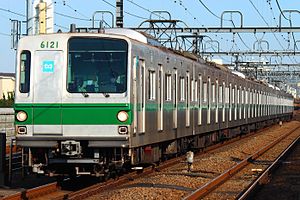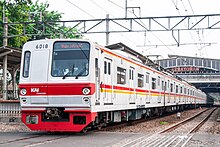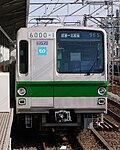| Tokyo Metro 6000 series | |
|---|---|
 Set 6121 in December 2014, currently operated in Indonesia Set 6121 in December 2014, currently operated in Indonesia | |
| In service | 1971–2018 (Tokyo Metro) 2011–present (KAI Commuter) |
| Manufacturer | Kawasaki Heavy Industries, Kinki Sharyo, Kisha Seizō, Nippon Sharyo, Tokyu Car Corporation |
| Replaced | Tokyo Metro 5000 series (Japan), 103 series, KRL Rheostatik, KRL Holec, KRL ABB Hyundai, KRL-I, and all non-air conditioned EMU (Indonesia) |
| Constructed | 1968–1990 |
| Entered service | 20 March 1971 |
| Refurbished | 1988–2007 |
| Scrapped | 2010– |
| Number built | 36 sets (353 vehicles) |
| Number in service | 25 sets (228 vehicles) for Kereta Commuter Indonesia |
| Number preserved | 2 sets (13 vehicles) |
| Number scrapped | 122 vehicles (8 sets in Japan + 42 carriages in Indonesia) |
| Successor | Tokyo Metro 16000 series |
| Formation | 3/8/10 cars per trainset |
| Capacity | 136 (48 seating) (end cars), 144 (54 seating) (intermediate cars) |
| Operators | Eidan/TRTA (1971–2004) Tokyo Metro (2004–2018) KAI Commuter (2011–present) |
| Depots | Ayase (Tokyo Metro) Depok, Bogor, Bukit Duri, Manggarai (KCI) |
| Lines served | Former: Tokyo Metro: OH Odakyu Odawara Line, OT Odakyu Tama Line (All stopped 2018), Indonesia: Current: KAI Commuter: |
| Specifications | |
| Car body construction | Aluminium |
| Car length | 20,000 mm (65 ft 7 in) |
| Width | 2,870 mm (9 ft 5 in) |
| Height | 4,135 mm (13 ft 6.8 in) |
| Doors | 4 per car |
| Maximum speed | Japan: 80 km/h (50 mph) (Chiyoda Line) 90 km/h (56 mph) (Joban Line) 100 km/h (62 mph) (Odawara Line) Indonesia: 70 km/h (43 mph) (on most lines) 95 km/h (59 mph) (Cikarang Loop Line; between CKR-JNG only) |
| Weight | 22.5–33 t (22.1–32.5 long tons; 24.8–36.4 short tons) (1st-5th batches), 24.8–36.1 t (24.4–35.5 long tons; 27.3–39.8 short tons) (6th batch onwards) |
| Traction system | Chopper control, IGBT-VVVF, Hitachi VVVF, Mitsubishi VVVF |
| Transmission | Westinghouse-Natal Drive; Gear ratio: 6.53 : 1 |
| Acceleration | 3.3 km/(h⋅s) (2.1 mph/s) |
| Deceleration | 3.7 km/(h⋅s) (2.3 mph/s) (service), 4.7 km/(h⋅s) (2.9 mph/s) (emergency) |
| Electric system(s) | 1,500 V DC overhead |
| Bogies | FS-378/FS-378A, FS-378B, FS-523 |
| Braking system(s) | Regenerative braking |
| Safety system(s) | CS-ATC, Odakyu ATS |
| Coupling system | Shibata coupler |
| Track gauge | 1,067 mm (3 ft 6 in) |
The Tokyo Metro 6000 series (東京メトロ6000系, Tōkyō Metoro 6000-kei) was an electric multiple unit (EMU) train type operated by the Tokyo subway operator Tokyo Metro on the Tokyo Metro Chiyoda Line in Tokyo, Japan from 1971 to 2018. A number of trainsets have been exported to Indonesia for use by Kereta Commuter Indonesia following their withdrawal in Japan.
The trains have 20-metre (66 ft) aluminium 4-door cars, and are used on the Chiyoda Line, as well as Odakyu Odawara Line, and Joban Line (all-stations "local" services). The sole three-car set was used on the Chiyoda Line Kita-Ayase branch line.
Fleet
- 6000: 1st prototype (1968)
- 6101: 2nd prototype (1969)
- 6102–6121: full production 1st–3rd full-production batch type
- 6122–6135: full production 4th–7th full-production batch type
As of 1 April 2018, the remaining fleet still operating in Japan consisted of 2 ten-car sets (sets 02 and 30).
The 6000 series was scheduled for its final commercial operation on 13 October 2018. They were finally retired from service on 11 November 2018, after their final seasonal run. The last trainset retired was Set 30. It was shipped to Jakarta, Indonesia at the end of 2018.
Formations
Trains are formed as follows, with car 1 at the southern end.
Set 01
| Car no. | 1 | 2 | 3 | 4 | 5 | 6 | 7 | 8 | 9 | 10 |
|---|---|---|---|---|---|---|---|---|---|---|
| Designation | CM1 | M2 | T1 | Tc1 | M1 | M2 | Tc2 | M2 | M1 | CM2 |
| Numbering | 6101 | 6201 | 6701 | 6601 | 6301 | 6401 | 6501 | 6801 | 6901 | 6001 |
Cars 1 and 3 each have one lozenge-type pantograph, and cars 5 and 9 each have two.
Sets 02–21
| Car no. | 1 | 2 | 3 | 4 | 5 | 6 | 7 | 8 | 9 | 10 |
|---|---|---|---|---|---|---|---|---|---|---|
| Designation | CT1 | M1 | M2 | Tc1 | M1 | M2 | Tc2 | T2 | M1 | CM2 |
| Numbering | 61xx | 63xx | 64xx | 65xx | 67xx | 68xx | 66xx | 62xx | 69xx | 60xx |
Cars 2, 5, and 9 each have two lozenge-type pantographs.
Sets 22–35
| Car no. | 1 | 2 | 3 | 4 | 5 | 6 | 7 | 8 | 9 | 10 |
|---|---|---|---|---|---|---|---|---|---|---|
| Designation | CT1 | T2 | M1 | M2 | Tc1 | Tc2 | M1 | M2 | M1 | CT2 |
| Numbering | 61xx | 62xx | 63xx | 64xx | 65xx | 66xx | 67xx | 68xx | 69xx | 60xx |
Cars 3, 7, and 9 each have two lozenge-type pantographs.
Set 60
| Car no. | 1 | 2 | 3 |
|---|---|---|---|
| Designation | CT | M1 | CM2 |
| Numbering | 6000-1 | 6000-2 | 6000-3 |
Cars 1 and 2 each have one lozenge-type pantograph.
Interior
-
 Interior of the three-car prototype
Interior of the three-car prototype
-
 Interior of a typical Tokyo Metro 6000 series train
Interior of a typical Tokyo Metro 6000 series train
-
Plaque of the 1972 Laurel Prize awarded to the 6000 series
History

The TRTA 6000 series won the 1972 Laurel Prize from the Japan Railfan Club.
Refurbishment
The fleet was retro-fitted with air conditioning between 1988 and 1994. The fleet then underwent a programme of refurbishment between 1988 and 2007.
Retirement
| This section does not cite any sources. Please help improve this section by adding citations to reliable sources. Unsourced material may be challenged and removed. (November 2024) (Learn how and when to remove this message) |
The 6000 series trains have been in service since 1971, and have begun to show their age. In the 2010's, Tokyo Metro thought the 6000 series were becoming unreliable. As of 2018, they have been replaced by the 16000 series.
Resale to Indonesia



A number of 6000 series sets have been shipped to Kereta Commuter Indonesia in Jakarta, Indonesia, as listed below.
VVVF refurbished sets were shipped to Indonesia from 2016, with the first three sets arriving at the Port of Tanjung Priok in Jakarta on 29 July 2016.
The earlier chopper-controlled sets run as eight-car formations, while the refurbished VVVF-controlled sets operate as ten-car formations. However, some sets are shortened to make it easier for repairs.
| Set no. | Date shipped |
|---|---|
| 6101 | 2016 |
| 6105 | 2012 |
| 6106 | September 2011 |
| 6107 | 2012 |
| 6108 | 2016 |
| 6111 | 2012 |
| 6112 | September 2011 |
| 6113 | 2012 |
| 6115 | January 2011 |
| 6116 | 2016 |
| 6117 | 2016 |
| 6118 | 2016 |
| 6119 | 2017 |
| 6120 | 2017 |
| 6121 | |
| 6122 | 2018 |
| 6123 | 2012 |
| 6124 | 2017 |
| 6125 | 2012 |
| 6126 | January 2011 |
| 6127 | 2012 |
| 6129 | 2017 |
| 6130 | 2018 |
| 6131 | 2016 |
| 6132 | 2017 |
| 6133 | 2012 |
| 6134 |
Training set

The three-car prototype set 6000, used on the Kita-Ayase branch line until 2014, is used as a staff training unit at Shin-Kiba Depot in Koto, Tokyo.
Fleet history
The individual set histories are as shown below.
| Batch | Set no. | Manufacturer | Build date | Refurbishment date | Withdrawal date | Remarks |
|---|---|---|---|---|---|---|
| 1st prototype | 6000-1 | Kisha Seizo | 16 April 1968 | - | For training purposes only. | |
| 2nd prototype | 6101 | Kawasaki Heavy Industries | 27 August 1969 | 28 January 1999 | 20 May 2016 | Shipped to Indonesia in 2016 |
| 1st batch | 6102 | 5 February 1971 | 17 July 1996 | 11 November 2018 | Preserved in Kita-Ayase depot. | |
| 6103 | - | 26 September 2011 | ||||
| 6104 | 9 August 1995 | March 2016 | ||||
| 6105 | 12 March 1971 | - | 10 September 2012 | Shipped to Indonesia | ||
| 6106 | Nippon Sharyo | 5 February 1971 | 6 January 1998 | 9 September 2011 | ||
| 6107 | 18 January 1991 | 30 January 2012 | ||||
| 6108 | Tokyu Car Corporation | 12 March 1971 | 11 May 1998 | 21 June 2016 | Shipped to Indonesia in 2016 | |
| 6109 | Kawasaki Heavy Industries | 5 February 1971 | April 1988 | 23 October 2015 | ||
| 6110 | Kinki Sharyo | 12 March 1971 | - | 1 October 2010 | ||
| 6111 | Nippon Sharyo | 5 February 1971 | 13 August 2012 | Shipped to Indonesia
Scrapped at Depok Depot in 2024. | ||
| 6112 | Kisha Seizo | 12 March 1971 | 31 August 1990 | 8 September 2011 | Shipped to Indonesia
Scrapped at Cikaum in 2016. | |
| 6113 | - | 20 August 2012 | ||||
| 2nd batch | 6114 | Kawasaki Heavy Industries | 22 August 1972 | 25 November 1996 | January 2016 | |
| 6115 | 6 September 1972 | - | 20 January 2011 | Shipped to Indonesia in 2011 | ||
| 6116 | 22 August 1972 | 9 November 1995 | 15 August 2016 | Shipped to Indonesia in 2016 | ||
| 6117 | Nippon Sharyo | 6 September 1972 | 18 September 1998 | 27 June 2016 | Shipped to Indonesia in 2016 | |
| 6118 | Tokyu Car Corporation | 13 June 1997 | 29 August 2016 | Shipped to Indonesia in 2016 | ||
| 6119 | Kisha Seizo | 22 August 1972 | 24 February 1997 | 30 January 2017 | Shipped to Indonesia in 2017 | |
| 3rd batch | 6120 | Kawasaki Heavy Industries | 7 October 1977 | 29 August 1997 | 29 May 2017 | Shipped to Indonesia in 2017 |
| 6121 | Nippon Sharyo | 21 September 1977 | July 2000 | 21 April 2017 | ||
| 4th batch | 6122 | Kinki Sharyo | 10 April 1981 | 30 March 2007 | 27 January 2018 | Shipped to Indonesia in 2018 |
| 6123 | Nippon Sharyo | - | 2 February 2012 | Shipped to Indonesia | ||
| 6124 | Kawasaki Heavy Industries | 15 May 1981 | 6 January 2004 | 10 April 2017 | Shipped to Indonesia in 2017 | |
| 6125 | 26 June 1981 | - | 17 February 2012 | Shipped to Indonesia
Scrapped at Depok Depot in 2024. | ||
| 6126 | Nippon Sharyo | 31 July 1981 | 11 January 2011 | Shipped to Indonesia in 2011 | ||
| 6127 | 26 August 1981 | 17 September 2012 | Shipped to Indonesia in 2012 | |||
| 6128 | Kawasaki Heavy Industries | 14 September 1981 | 17 June 2004 | 6 December 2015 | ||
| 5th batch | 6129 | Nippon Sharyo | 24 November 1984 | 18 October 2006 | 10 July 2017 | Shipped to Indonesia in 2017 |
| 6130 | Kinki Sharyo | 12 December 1984 | 21 November 2005 | 11 November 2018 | Shipped to Indonesia in 2018 | |
| 6131 | Tokyu Car Corporation | 11 January 1985 | 16 May 2005 | 10 October 2016 | Shipped to Indonesia in 2016 | |
| 6132 | Kawasaki Heavy Industries | 21 February 1985 | 17 May 2006 | 27 March 2017 | Shipped to Indonesia in 2017 | |
| 6th batch | 6133 | Kinki Sharyo | 8 October 1988 | - | 3 September 2012 | Shipped to Indonesia. |
| 6134 | 24 October 1988 | 27 August 2012 | ||||
| 7th batch | 6135 | Tokyu Car Corporation | 26 September 1990 | 12 December 2011 |
- Cars 6501 to 6801 were built in February 1971.
Related development
| This section does not cite any sources. Please help improve this section by adding citations to reliable sources. Unsourced material may be challenged and removed. (July 2022) (Learn how and when to remove this message) |
Both the Tokyo Metro 7000 series and the Tokyo Metro 8000 series were based on the 6000 series for the Yurakucho Line, Fukutoshin Line, and the Hanzomon Line. The cab car was inspired by Bay Area Rapid Transit (BART) in the San Francisco Bay Area, thus created the A-cars as the end cars only.
Gallery
-
 Air-conditioning for the 6000 series; the fan was used for air circulation before the retrofitting of air-conditioning.
Air-conditioning for the 6000 series; the fan was used for air circulation before the retrofitting of air-conditioning.
-
Jumper coupler for the 6000 series
-
 The prototype of the 6000 series, which was used on the Ayase branch
The prototype of the 6000 series, which was used on the Ayase branch
-
 FS378 bogie for the 6000 series
FS378 bogie for the 6000 series
-
 FS523 bogie for the 6000 series
FS523 bogie for the 6000 series
-
 Chopper control as used on the 6000 series
Chopper control as used on the 6000 series
-
 VVVF control as used on the 6000 series
VVVF control as used on the 6000 series
-
Builder's plate on the 6000 series prototype
-
 A 6000 series unit bearing the farewell run decals, July 2019
A 6000 series unit bearing the farewell run decals, July 2019
-
 Set 6132 and 6115 in Indonesia, February 2021
Set 6132 and 6115 in Indonesia, February 2021
-
 Set 6132 with new KAI Commuter livery scheme, December 2020.
Set 6132 with new KAI Commuter livery scheme, December 2020.
References
- 私鉄車両編成表 2016 [Private Railway Rolling Stock Formations - 2016] (in Japanese). Japan: Kotsu Shimbunsha. 25 July 2016. pp. 74–75. ISBN 978-4-330-70116-5.
- 千代田線6000系車両が引退します [Chiyoda Line 6000 series retires] (PDF). tokyometro.jp (in Japanese). Japan: Tokyo Metro. 28 September 2018. Archived from the original (PDF) on 5 September 2019. Retrieved 29 September 2018.
- ^ 私鉄車両編成表 2015 [Private Railway Rolling Stock Formations - 2015] (in Japanese). Japan: Kotsu Shimbunsha. 23 July 2015. pp. 72–73. ISBN 978-4-330-58415-7.
- ^ Kekke, Manabu (June 2016). 本数を減らす東京メトロ6000系の現況 [The current state of the dwindling Tokyo Metro 6000 series]. Tetsudo Daiya Joho Magazine (in Japanese). Vol. 45, no. 386. Japan: Kotsu Shimbun. pp. 30–35.
- "KERETA API: KCJ Tambah KRL Untuk Perbanyak Kapasitas Angkut" [RAILWAY: KCJ Adds Train Fleet to Expand Capacity] (in Indonesian). Indonesia: Bisnis.com. 29 July 2016. Retrieved 31 July 2016.
- Takagi, Satoru (January 2018). ジャカルタ 東京地下鉄関連の車両 [Tokyo Metro rolling stock in Jakarta]. Japan Railfan Magazine (in Japanese). Vol. 58, no. 681. Japan: Koyusha Co., Ltd. pp. 120–121.
- ^ 私鉄車両のうごき [Private railway rolling stock changes]. Tetsudo Daiya Joho Magazine (in Japanese). Vol. 45, no. 390. Japan: Kotsu Shimbun. October 2016. p. 127.
- ^ 私鉄車両のうごき [Private Rail Rolling Stock Changes]. Tetsudō Daiya Jōhō Magazine. Vol. 42, no. 345. Japan: Kotsu Shimbun. January 2013. p. 127.
- ^ 千代田線6000系、さらに6106・6112編成がインドネシアへ [Chiyoda Line 6000 series to Indonesia]. Japan Railfan Magazine. Vol. 52, no. 609. Japan: Koyusha Co., Ltd. January 2012. p. 174.
- ^ 私鉄車両のうごき [Private Rail Rolling Stock Changes]. Tetsudō Daiya Jōhō Magazine. Vol. 41, no. 339. Japan: Kotsu Shimbun. July 2012. p. 127.
- ^ 私鉄車両のうごき [Private railway rolling stock changes]. Tetsudo Daiya Joho Magazine (in Japanese). Vol. 46, no. 393. Japan: Kotsu Shimbun. January 2017. p. 127.
- ^ 私鉄車両のうごき [Private railway rolling stock changes]. Tetsudo Daiya Joho Magazine (in Japanese). Vol. 46, no. 399. Japan: Kotsu Shimbun. July 2017. p. 127.
- ^ 私鉄車両のうごき [Private railway rolling stock changes]. Tetsudo Daiya Joho Magazine (in Japanese). Vol. 46, no. 402. Japan: Kotsu Shimbun. October 2017. p. 127.
- ^ "Nyaris Datang Tahun Lalu, KRL Seri 6000 Rangkaian 6122F Buka Impor KRL 2018". www.re-digest.web.id.
- ^ 私鉄車両のうごき [Private railway rolling stock changes]. Tetsudo Daiya Joho Magazine (in Japanese). Vol. 47, no. 405. Japan: Kotsu Shimbun. January 2018. p. 105.
- ^ 私鉄車両のうごき [Private railway rolling stock changes]. Tetsudo Daiya Joho Magazine (in Japanese). Vol. 46, no. 396. Japan: Kotsu Shimbun. April 2017. p. 128.
- Shibata, Togo (March 2017). 非公開の保存車両に注目 [Looking at rolling stock preserved in private]. Tetsudo Daiya Joho Magazine (in Japanese). Vol. 46, no. 395. Japan: Kotsu Shimbun. p. 59.
External links
- Tokyo Metro Chiyoda Line 6000 series information (in Japanese)
| Trainsets of the Tokyo Metro | ||
|---|---|---|
| Current |  | |
| Former | ||
| In service | |||||
|---|---|---|---|---|---|
| Retired |
| ||||
| Future |
| ||||